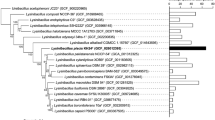Abstract
Molecular identification of microalgal species is vital and involves sequencing of specific markers present in the genome, which are unique to a genus. PCR is a vital tool for identification of microalgae; the preparation of template DNA for PCR by traditional methods requires large amount of algal cells and a time-consuming process. One simple way to reduce these complications is to use the microalgal colonies directly for amplification of required DNA fragments from the genome. In this study, a simple cell-disrupting method, using autoclaved glass powder, has been used for direct colony PCR of microalgae. Four morphologically different microalgal strains were chosen from freshwater samples, and the PCR amplification reaction was evaluated with three different molecular markers (rbcL, internal transcribed spacer 2, and 18S rDNA). PCR amplification was optimized with less number of cells (0.04 × 105), minimal quantity of glass powder (0.5 mg), and in the presence of Milli-Q water for internal transcribed spacer marker. The isolated strains were identified as Desmodesmus sp. JQ782747, Coelastrum proboscideum JQ898144, Chlorella sorokiniana JQ898145, and Scenedesmus sp. JQ782746 based on sequence similarity. This direct microalgal colony PCR proves to be a simple and rapid method for detection of varied microalgal species.




Similar content being viewed by others
References
Cao M, Fu Y, Guo Y, Pan J (2009) Chlamydomonas (Chlorophyceae) colony PCR. Protoplasma 235:107–110
Chisti Y (2007) Biodiesel from microalgae. Biotechnol Adv 25:294–306
Doyle JJ, Doyle JL (1990) A rapid total DNA preparation procedure for fresh plant tissue. Focus 12:13–15
Fawley MW, Fawley KP (2004) A simple and rapid technique for the isolation of DNA from microalgae. J Phycol 40:223–225
Ghosh S, Love NG (2011) Application of rbcL based molecular diversity analysis to algae in wastewater treatment plants. Bioresour Technol 102:3619–3622
Gors M, Schumann R, Hepperle D, Karsten U (2010) Quality analysis of commercial Chlorella products used as dietary supplement in human nutrition. J Appl Phycol 22:265–276
Hall JD, Fucikova K, Lo C, Lewis LA, Karol KG (2010) An assessment of proposed DNA barcodes in freshwater green algae. Cryptogam Algol 31:529–555
Hegewald E, Wolf M, Keller A, Friedl T, Krienitz L (2010) ITS2 sequence-structure phylogeny in the Scenedesmaceae with special reference to Coelastrum (Chlorophyta, Chlorophyceae), including the new genera Comasiella and Pectinodesmus. Phycologia 49:325–335
Kaur S, Sarkar M, Srivastava RB, Gogoi HK, Kalita MC (2012) Fatty acid profiling and molecular characterization of some freshwater microalgae from India with potential for biodiesel production. N Biotechnol 29:332–344
Liam B, Philip O (2010) Biofuels from microalgae—a review of technologies for production, processing, and extractions of biofuels and co-products. Renew Sust Energ Rev 14:557–577
Lim SL, Chu WL, Phang SM (2010) Use of Chlorella vulgaris for bioremediation of textile waste water. Bioresour Technol 101:7314–7322
Matsumoto M, Sugiyama H, Maeda Y, Sato R, Tanaka T, Matsunaga T (2010) Marine diatom, Navicula sp. strain JPCC DA0580 and marine green alga, Chlorella sp. strain NKG400014 as potential sources for biodiesel production. Appl Biochem Biotechnol 161:483–490
Matsunaga T, Matsumoto M, Maeda Y, Sugiyama H, Sato R, Tanaka T (2009) Characterization of marine microalga, Scenedesmus sp. strain JPCC GA0024 toward biofuel production. Biotechnol Lett 31:1367–1372
Moniz MBJ, Kaczmarska I (2009) Barcoding diatoms: is there a good marker? Mol Ecol Resour 9:65–74
Neustupa J, Skaloud P, Stastny J (2010) The molecular phylogenetic and geometric morphometric evaluation of Micrasterias crux-melitensis/M. radians species complex. J Phycol 46:703–714
Novis PM, Halle C, Wilson B, Tremblay LA (2009) Identification and characterization of freshwater algae from a pollution gradient using rbcL sequencing and toxicity testing. Arch Environ Contam Toxicol 57:504–514
O’kelly CJ, Kurihara A, Shipley TC, Sherwood AR (2010) Molecular assessment of Ulva spp. (Ulvophyceae, Chlorophyta) in the Hawaiian Islands. J Phycol 46:728–735
Pittman JK, Dean AP, Osundeko O (2011) The potential of sustainable algal biofuel production using waste water resources. Bioresour Technol 102:17–25
Punekar NS, Suresh Kumar SV, Jayashri TN, Anuradha R (2003) Isolation of genomic DNA from acetone-dried Aspergillus mycelia. Fungal Genet Newsl 50:15–16
Rasoul-Amini S, Ghasemi Y, Morowvat MH, Mohagheghzadeh A (2009) PCR amplification of 18S rRNA, Single Cell Protein production and fatty acid evaluation of some naturally isolated microalgae. Food Chem 116:129–136
Ratha SK, Prasanna R, Gupta V, Dhar DW, Saxena AK (2012) Bioprospecting and indexing the microalgal diversity of different ecological habitats of India. World J Microbiol Biotechnol 28:1657–1667
Sluiman HJ, Guihal C, Mudimu O (2008) Assessing phylogenetic affinities and species delimitations in Klebsormidiales (Streptophyta): nuclear-encoded rDNA phylogeny and its secondary structure models in Klebsormidium, Hormidiella, and Entransia. J Phycol 44:183–195
Stanier RY, Kunisawa MM, Cohen-Bazire (1971) Purification and properties of unicellular blue-green algae (order Chroococcales). Bact Res 35:171–201
Tseng CK (2001) Algal biotechnology industries and research activities in China. J Appl Phycol 13:375–380
Wan M, Rosenberg JN, Farug J, Betenbaugh MJ, Xia J (2011) An improved colony PCR procedure for genetic screening of Chlorella and related microalgae. Biotechnol Lett 33:1615–1619
Woodman ME (2008) Direct PCR of intact bacteria (colony PCR). Curr Protoc Microbiol Appendix 3: Appendix 3D
Yang X, Liu P, Hao Z, Shi J, Zhang S (2012) Characterization and identification of freshwater microalgal strains toward biofuel production. BioResources 7(1):686–695
Zamora I, Feldman JL, Marshall WF (2004) PCR-based assay for mating type and diploidy in Chlamydomonas. Biotechniques 37:534–536
Acknowledgments
We are grateful to the management of SRM University for providing fund and infrastructure facility for this project.
Author information
Authors and Affiliations
Corresponding author
Rights and permissions
About this article
Cite this article
Radha, S., Fathima, A.A., Iyappan, S. et al. Direct colony PCR for rapid identification of varied microalgae from freshwater environment. J Appl Phycol 25, 609–613 (2013). https://doi.org/10.1007/s10811-012-9895-0
Received:
Revised:
Accepted:
Published:
Issue Date:
DOI: https://doi.org/10.1007/s10811-012-9895-0




